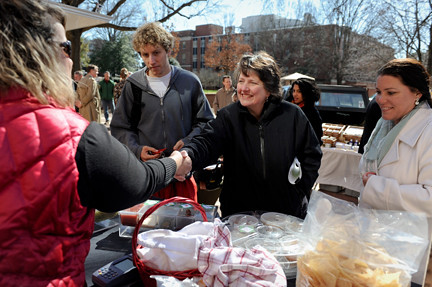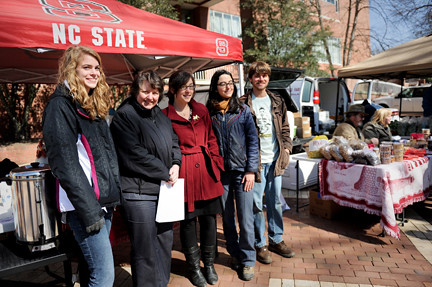
Before kicking off this year’s ‘Know Your Farmer, Know Your Food’ college tour in North Carolina, I took a moment to reflect on why these college visits are so important. As President Obama said in his State of the Union address, we must out-educate the world in order to win the future. Indeed, during the eight years that I spent as a college professor, I was constantly reminded that investing in our nation’s young minds is investing in our nation’s future. With this in mind, this year, members of USDA leadership will join the Secretary and myself in engaging America’s youth in a critical dialogue about our food system, our rural economy, and the economic opportunities associated with local and regional markets.
I began this year’s college tour with stops at North Carolina A & T University and North Carolina State University for an important reason. Students at both of these universities have been working with the Center for Environmental Farming Systems (CEFS), on an incredible campaign--North Carolina’s 10% Campaign. The 10% Campaign challenges North Carolinians to spend just 10 percent of their existing food dollars on goods produced by North Carolina’s own farmers and ranchers. By doing this, North Carolinians would infuse approximately $3.5 billion dollars annually into the local state economy. This effort represents exactly the kind of exciting innovation that the Secretary and I think is key to rural revitalization.
While on campus, I gave a lecture to students on why agricultural policy mattered to their lives and helped them to understand how they could get involved. I explained the myriad opportunities for internships and employment at USDA, and encouraged them to look into careers as agricultural economists, agricultural journalists, agricultural engineers, and, of course, as farmers and ranchers.
During the tour, I utilized polling technology that allowed audience members to use hand-held remotes, called i-clickers, to vote on multiple choice questions that I asked. On every college campus I visit, participants are shocked to find out that nutrition assistance—not farm subsidies—makes up the majority of the USDA budget (almost 4.5 times the amount of any other expenditure). In fact, I’ve never had an audience correctly answer my question of what makes up the largest share of the USDA budget. This, to me, underscores the necessity of this national conversation. The next generation needs to better understand agricultural policy if they hope to provide solutions to the challenges of our future.
But the excitement didn’t end there. We also brought the good news with us that USDA is supplying North Carolina State University (NCSU) with a grant to develop an obesity prevention program that increases access to healthy food and safe places for physical activity. This announcement was delivered as part of the first anniversary celebration of First Lady Michelle Obama’s Let’s Move! initiative.
This commitment to research will help prevent obesity, as well as create a healthier environment not only in North Carolina, but across the country.
This year, along with Secretary Vilsack and other subcabinet members, we intend to travel to over forty campuses. It will be a fun and informative tour, so check back to the USDA blog or read our twitter to find out where we’re headed next!


